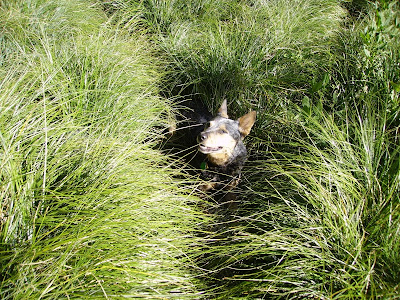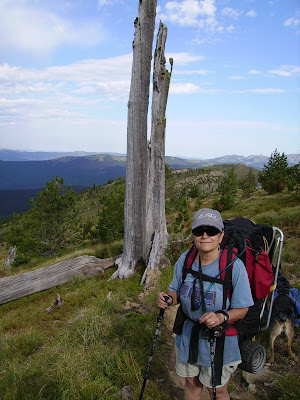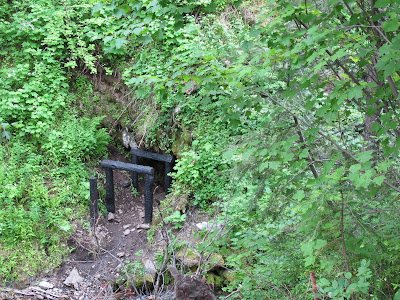One of our biggest adventures was a two-night backpack trip to Dalton Lake, which was highly recommended because of its ease in catching cutthroat trout. The lake is one of three along a portion of the Stateline Trail, which, true to its name, traverses along the ridge tops of the Bitterroot Mountains, with spectacular views of Idaho to the west and Montana to the east. It's also part of a proposed wilderness area called The Great Burn, an area where the nation's largest firestorm roared through in 1910.
I had some trepidation about taking this on, as it has been three years since we’ve donned backpacks. But my biggest concern centered around encountering creatures of the Ursus variety, as in ursus americanus and Ursus arctos horribilis,(otherwise known as the black bear and grizzly bear). I don’t think my fear was entirely unfounded: this summer, there was the fatal grizzly rampage at a Yellowstone-area campground and the Glacier episode where Jack Hanna pepper sprayed a charging grizzly.
But closer to here, there’s been more black bear encounters, and they’ve occurred when a camper is most vulnerable: asleep in a tent. While there have been no fatalities, one camper’s ear was chewed on, requiring over 40 stitches to set things straight.
Nevertheless, we set out on a beautiful bluebird-sky day. The trail into Dalton is about 7 miles, and includes several steep climbs (something I wasn’t prepared for. When trekking along ridgetops, one would expect level ground, right?? Not!) But the most difficult section was the hike down into the lake itself, which required an 800-foot descent in about 3/4 mile. In other words: steep! Of course, this meant we would have to do this trail in reverse on our way out, (bad mental picture).The descent was not without its rewards as we passed through large swaths of bright pink fireweed.
Once we got down, it was indeed a beautiful spot. The lake is bordered by a high glacial cirque on one end, a steep rocky slope plunging down to the water’s edge on another, and a nice rock outcropping on the side where we set up camp. And because the lake is remote and not fished out, the fish starting biting as soon as we “wet our lines.” Jim fulfilled his wish to have a fresh-caught trout dinner, cooked over a campfire.
Besides the cutthroat trout, the only other wild critters we encountered were mountain goats. Watching them skitter easily along precipitous rock ledges is an awesome sight. We also assume that the stomping sound we heard around our tent at night belonged to some type of hoofed animal, either a goat, deer, or moose. (While the sounds did evoke some anxiety on my part, we surmised that a bear would make a “thrashing, grunting-in-the-brush" type noise. At least, that’s what I told myself so I could get some semblance of sleep.)
The hike out was just as pretty as the hike in (made it to the top of the ridge over Dalton in about an hour), and got a closer look at a mountain goat ram up ahead on the trail. Once back to civilization we stopped at our favorite Huckleberry ice cream shop in Superior.
The huckleberries are indeed ripe, along with the service and choke berries, preferred bear food. Perhaps that’s why PBR (the name we have bestowed on what we assume is the same bear who raided our beer when we first arrived) has been hanging around, along with her two yearling cubs. But so far, she’s been a good bear, engaging only in bear-type behavior (no more beer for her!). Other critters around our Camp have been wild turkey, deer, and elk. We also had a moose wander into a campsite along the Lochsa River, where we spent a night at Jerry Johnson Hotsprings.
Well, this might be my last post from Montana. This weekend is the Rootfest in Missoula, and before we leave, we hope to bicycle the Hiawatha Trail, which is actually an old railroad bed winding through 10 tunnels and seven high trestles in the Bitterroot Mountains.
Connie's catch of the day
Dalton Lake

View of Dalton Lake from atop ridge (our campsite was on the point)

Jim cooking over campfire

Lacey in the Bear Grass

Sunrise over Dalton Lake

Connie on hike out: Could this be a snag from the 1910 fire? Maybe.

Q: What do bears do in the woods? A: Hang out behind our campsite!

Bullwinkle pays a visit

Jim at Jerry Johnson Hotsprings (moose came by later)















































